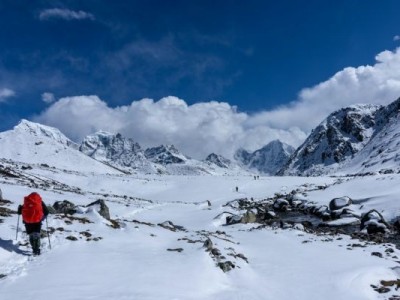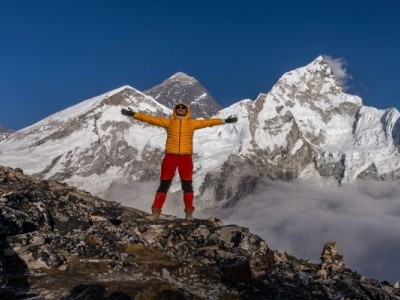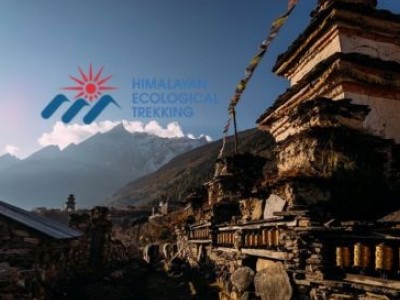Trekking Gear for Upper Dolpo
The Upper Dolpo trek requires ample preparation to stay safe and comfortable in one of Nepal's most remote and pristine wilderness areas in the trans-Himalayan region of Nepal. The trek takes you to elevations between 3,000 - 5,663 meters (Kang La Pass). You can expect amazing views of the Tibetan plateau, old monasteries, and stunning, untouched scenery in the Dolpo region. The Upper Dolpo trek is much longer than other Himalaya treks at 18-21 days, making it the ideal trip for experienced trekkers who are looking for an authentic wilderness experience.
Trekking gear forms the basis of your preparation for this difficult high-altitude trek. Quality equipment is critical - quality means suitable gear that is designed for severe weather, high altitude, and remote conditions. When selecting your trekking gear for Upper Dolpo, you want to prioritize durability, functionality, and trustworthiness in harsh mountain conditions.
- Backpack (65-75L): With the nature of your time in the Upper Dolpo trek being so long, you must have a well-supported, large backpack. Ideally, your pack will have multiple compartments for organization, good construction, and padded shoulder straps, as well as a well-supported waistbelt with support for your lower back.
- Trekking Poles: They are important in balancing rocky terrain and crossings over a river, loose scree, and steep mountain passes. You will travel over a range of terrains from barren landscapes to rocky high passes, so the poles will be useful for maintaining balance and protecting your knees.
- Sleeping Bag (-20 /-25 °C): You will encounter extreme temperatures in Upper Dolpo above a certain altitude and time of year, so an expensive, high-quality sleeping bag is essential. You will not be able to rely on an adequate blanket or heating at all accommodation spots due to the remote nature of the trek.
- Headlamp with Extra Batteries: Essential for rural navigation during forced uses; early morning starts, or late arrivals at camps or basic lodges without electricity. Ensure to pack at least 3 sets - batteries do drain quickly even under cold conditions at altitude.
- Rain Cover for Backpack: Weather in the trans-Himalayan region is very unpredictable. Sudden storms can happen even when it seems it is "dry". A waterproof cover protects your gear from moisture and could be life-saving in extreme conditions.
- Waterproof Dry Bags: Different sizes of multiple dry bags to pack critical items like electronics, spare clothes, and documents. Protect from moisture, dust, dirt, etc.
Weather-Appropriate Clothing for Upper Dolpo

Being aware of the extremes in climate on your trek to Upper Dolpo is of utmost importance to ensure comfort and survivability. The trek will only be possible to do at certain times of the year (mainly May to October when the passes are usually in an open state). However, even in perfect seasons, it is common to find temperatures as hot as midday, in stark contrast to freezing temperatures at night.
The area is affected by the rain-shadow phenomenon, which creates a similar climate to a desert that experiences extreme levels of UV radiation, extreme temperature variations within a short period, and high and sustained wind gusts. The only secret to being weather-appropriate, about outfit choices, is utilizing a comprehensive layering system that can tolerate a single day varying from 30- 40° C.
- Base Layer: You should have high-quality merino wool or synthetic moisture-wicking thermal wear. Pack at least 3-4 sets with long-sleeve tops and bottoms. You will need a fresh base layer to wear quite often in the dry and dusty environment. Do not use cotton because it retains moisture and provides no insulation if wet.
- Insulation Layer: A high-quality down jacket of 700+ fill power is required for Upper Dolpo. Bring a heavy down jacket and a mid-weight fleece. You will need something serious for insulation due to the extreme cold at high passes, and early mornings and evenings. There will be a few cold nights, and because of that, synthetic insulation is a good option to pack as a backup layer.
- Outer Layer: Technical mountaineering-grade outer shell- full waterproof and windproof capability. The jacket and pants should provide a reinforced seam, also provide a snow skirt, and good venting systems. The winds in Upper Dolpo are no joke, and the wind protection will be crucial.
- Trekking Pants & Shorts: Durable, quick-drying trekking pants with reinforced knees and seats. Pack both lightweight hiking pants and insulated soft-shell pants for higher elevations. Also pack one comfortable pair of shorts for lower elevations.
Gloves, Hat & Buff: Pack multiple layers of hand protection: liner gloves, insulated gloves, and waterproof outer mitts. Include both a warm beanie and a sun hat with neck protection. A buff or balaclava is essential for wind and sun protection in the exposed terrain.
Related article: Best Time to Trek Upper Dolpo, Nepal - Spring & Fall Guide
Footwear Essentials
In Upper Dolpo, footwear selection is paramount because of the terrain of the environment. Footwear must accommodate river crossings, loose scree, snow, or sharp rocks. As a remote region, foot injuries in Upper Dolpo can be detrimental.
- Mountaineering Boots: Warm, insulated mountaineering boots are advisable for the high passes and cold weather. They should be waterproof, provide good ankle support, and be able to fit microspikes or crampons if you anticipate snow or ice.
- Trekking Boots: A second pair and type of lighter trekking boots for lower elevations and warmer days. They should be broken-in and waterproof, and provide good support for standing for long days over varied terrain.
- River Crossing Shoes: lightweight water shoes or sandals - for river crossings - which happen regularly in Upper Dolpo. These protect your feet from sharp rocks and the cold water, allowing you to keep your main boots dry.
- Camp Shoes: Insulated camp booties or down slippers to wear in the lodges and camps, which create comfort and warmth after long trekking days.
- Wool Socks & Liner Socks: At least 8-10 pairs of quality merino wool hiking socks. Include liner socks to help prevent blisters for the long trekking days. The extended duration of the trek also means that you will need adequate sock changes.
Altitude Sickness Prevention Items
Upper Dolpo ascends to extreme altitudes incredibly quickly, so altitude illness can pose serious dangers. When trekking up to maximum elevations of over 5,600 meters, even the best and most experienced high altitude trekkers will be affected. To reduce the risks involved, it is crucial to plan and take preventive measures.
Because Upper Dolpo is so remote, getting someone off the mountain who suffers from serious altitude sickness will be extremely difficult and expensive. Prevention should include acclimatization and prevention, medications specific to altitude illness, and careful monitoring while trekking to ensure a safe trip from altitude illness.
- Diamox (Acetazolamide): Critical medication for preventing/preventing altitude sickness. Speak with a physician with expertise in high altitude medicine before your trip, and bring enough for the entire expedition, plus extra in case of emergencies.
- Pulse Oximeter: A device that gives you a reading of your blood oxygen saturation and pulse rate. This information is important in recognizing early signs of altitude sickness and as a guide for your acclimatization.
- Water Purification System: Many options: tablets, UV sterilizer, good quality filter. There may be limited and contaminated water sources in Upper Dolpo, so dehydration is a risk factor for altitude sickness.
- Electrolyte Supplement: Powder or tablets to help keep you hydrated and avoid muscle cramps while doing strenuous high altitude trekking.
- Complete First Aid Kit: Must have medicines for severe headaches, nausea, diarrhea, respiratory issues, and wound care supplies. Include pain medications and antibiotics after consulting a physician.
Budget-Friendly Trekking Equipment
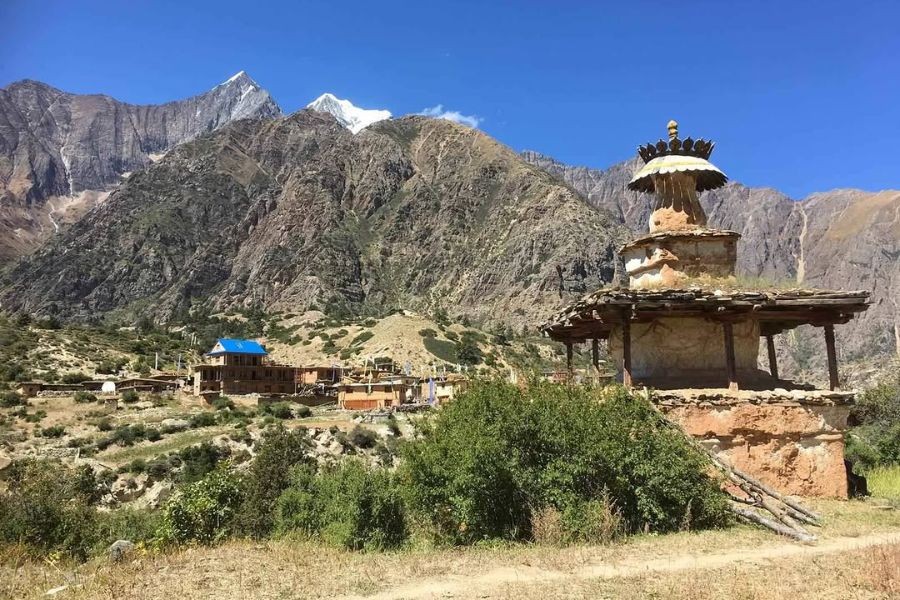
While Upper Dolpo requires high-quality gear due to its remote and challenging nature, strategic shopping can help manage costs without compromising safety.
- Equipment Rental in Kathmandu: Many specialized trekking shops in Thamel rent equipment if you want to save on renting expensive (and sometimes only used once) items such as down sleeping bags, mountaineering boots, and down jackets. This can save you quite a lot of money!
- Balance durability and cost: With essential safety aspects such as sleeping bags and outer shells, choose quality items. Considering pants and base layers, the local options can be good quality and save you quite a bit of money.
- Combine items: Choosing multi-purpose items when you can can help to save you money as well as weight. A good down jacket can also serve as insulation when you sleep, or your pillow when stuffed in a pillow case.
Photography Gear for Upper Dolpo
Upper Dolpo offers some of the most pristine and unique landscapes in the Himalayas, with opportunities to photograph ancient monasteries, traditional Tibetan culture, and untouched wilderness. The extreme conditions require special consideration for photography equipment.
- Weather-Sealed Camera: A camera capable of withstanding the dual threats of dust and moisture, plus capable of performing in extreme temperatures. Although mirrorless cameras tend to be lighter, make sure that they are rated to operate safely in the cold.
- Extra Batteries and Power Banks: The weather can wear down battery life quickly, especially in cold weather, so it is recommended to carry extra batteries and also high-capacity power banks when battery life is important. If you are not using extra batteries, then keep them warm near your body.
- Protective Filters: When shooting at high altitudes, it is important to shoot with a UV or polarizing filter if using a normal lens because the intense sunlight reflecting off rocks and snow can be dangerous, but a protective filter will help protect the front of your lens from dust and damage.
- Solid Tripod: Carry a tripod that will support your camera for long shutter speeds and for shooting sunrise/sunset shots. For extended distances, carbon fiber tripods offer the best strength-to-weight ratio.
Waterproof Storage: Several waterproof cases or dry bags to keep your camera gear clean from dust storms, rain, and snow.
Related article: Upper Dolpo Trek Cost Guide: Permit Fees & Package Pricing
Personal Hygiene Items for Extended Treks
Maintaining hygiene during the 18-21-day Upper Dolpo trek is crucial for health and comfort. Facilities are extremely basic, and often non-existent, requiring self-sufficiency in personal care.
- Biodegradable Soap and Shampoo: All-in-one biodegradable soap that can be used to wash hair, body, and clothes. It's important to have a low impact on this pristine environment.
- Wet Wipes and Toilet Paper: The wet wipes are biodegradable, and we'll use a lot for daily clean-ups in situations where washing facilities won't be available. Take as much toilet paper as you need for the trip, because you'll have to pack it in, as there's no toilet paper on the route.
- Hand Sanitizer: A large bottle of alcohol-based sanitizer (60% + alcohol) for before meals, and after toilet use (for frequent use). Proper hand hygiene is important to prevent illness when travelling in a more remote environment.
- Sunscreen and Lip Balm (SPF 50+): High SPF protection is important when washed over with UV radiation from the sun at altitude, as well as the UV reflection from the rock and snow. You should reapply frequently throughout the day.
- Personal Medications: Any prescription medications plus a backup or two for a trip this long. Don't forget medications for any personal medical needs, and you'll want anti-diarrheal medication and pain relief medications.
- Dental Care Kit: Toothbrush, toothpaste, and floss for the duration of the trip, with a spare toothbrush if you should lose or break it.
Camping Trek Packing List Details
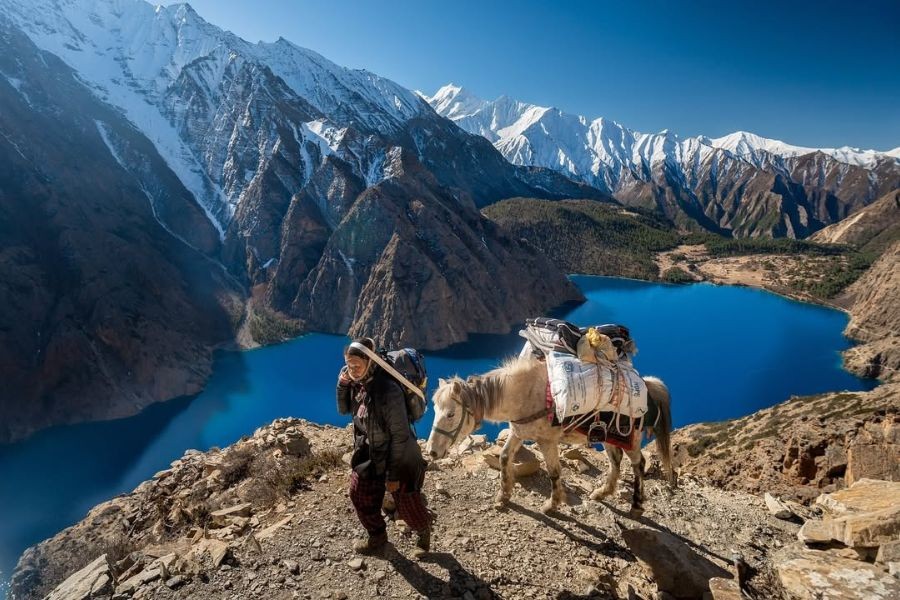
Upper Dolpo often requires camping in remote areas where no accommodation exists. This significantly increases gear requirements and the need for self-sufficiency. Proper camping equipment is essential for safety and survival in this harsh environment.
Shelter and Sleep System
- Four-Season Tent: A durable, four-season mountaineering tent designed to withstand significant winds, snow loading, and severe weather. As you're using this tent for high-altitude conditions, you'll want to ensure that the tent also includes great ventilation and has features that will minimize condensation.
- Sleeping Pad: It's important to have a sleeping pad with a high capacity R-value (5.0+) insulated sleeping pad to insulate your torso from becoming chilled from the frozen ground. I recommend bringing two sleeping pads: a closed-cell foam insulated pad to provide heat retention, and an inflatable pad to provide comfort.
- Pillow: An inflatable pillow or stuff sack pillow system for comfort on your extended trek, as adequate sleep is important for acclimatization and daily performance.
Cooking and Food Preparation
- Heating and Cooking: An efficient high altitude stove that works well in cold temperature conditions and at high elevation.. Liquid fuel stoves are usually more efficient than canister stoves in extreme conditions. Bring extra fuel in consideration of the longer days.
- Cookware Set: Lightweight but durable pots, pans, utensils for the whole gang. And extra cutlery and a knife, a cutting board, and tools to prep food. Ensure items are compact and multi-use.
- Food Storage: Containers that are resistant to rodents and bears. Multiple drybags and containers for organizing and protecting food supplies from moisture and contamination.
- Water Storage and Treatment: If base camping for more than a few days, you will be a distance from your water sources and carrying large (10-20L) water containers to move to the base camp from the water source. Multiple methods of treatment, such as filters, purification tablets, and even UV sterilizers, are recommended.
Camping Comfort and Organization
- Portable Chairs: Lightweight camp chairs for comfort on long nights at base camps. This greatly enhances the quality of life during a longer trek.
- Table and Kitchen set up: Portable camp table or tarp for food prep and eating. Include a wash station set up for dishes and personal hygiene.
- Lighting system: Lanterns for camp lighting in addition to headlamps; solar charging features might be useful on a longer use basis.
- Tarps and Ground Covers: Heavy-duty tarps for added weather protection, ground covers, and gear organization around camp.
Emergency and Safety Equipment
- Communication Device: A satellite communicator or emergency beacon that will allow you to communicate in areas with no cell coverage. This is critical for emergencies in remote areas.
- Expanded First Aid Kit: A fully stocked medical kit to include prescription medications, emergency treatments, and supplies to treat a more serious injury or illness.
- Repair Kit: A wide array of supplies for repairs, including tent repair patches, duct tape, repair materials for gear, and some tools to maintain your gear.
- Emergency Shelter: A lightweight emergency bivy, or tarp for emergencies, separate from your routine shelter.
FAQs
What's the weather like on the Upper Dolpo trek, and how should I pack accordingly?
Extremes in weather are not uncommon in Upper Dolpo, with temperatures potentially varying from over 25 degrees Celsius during the day to -20 degrees Celsius at night, especially at the high passes. Trekking in Upper Dolpo is limited by the high passes, so late May to the end of October are the optimal periods to complete these treks. Although this is the most weather-stable time, there can still be sudden weather changes. You should prepare for extreme temperature changes by using a comprehensive layered system of clothing while being prepared for sudden storms, high winds, and snow, even during the "good" trekking months.
Do I need specialized high-altitude gear for Upper Dolpo, or will regular trekking equipment suffice?
Due to the elevation, extreme remoteness, and harsh conditions of Upper Dolpo, I would take specialist high altitude expedition gear, and regular trekking gear will not meet the challenges involved. What you should be looking at are mountaineering quality boots, expedition sleeping bags rated for extreme cold, four-season tents for the camping sections, and complete emergency equipment - the results of equipment failure are far more consequential than on usual treks!
How much should my backpack weigh for the Upper Dolpo trek?
Regarding Upper Dolpo, we recommend your pack weighing 15-20 kilograms since you'll require fully equipped and well-layered gear, camping equipment, and provisions for the longer period. This will be heavier than a shorter trek, but it is necessary for safety in this isolated place. Consider hiring porters to carry the base camp supplies, while you carry a day pack with essentials for a day's trek.
Are there shops or facilities along the Upper Dolpo route to resupply?
Upper Dolpo has very few facilities available, and no realistic supply shops or resupply points along almost all of the path. You'll most likely have to carry or arrange for the carrying of everything you need from Kathmandu or the last supply point, Dunai. There are teahouses in some villages, but don't count on having trekking gear, medical supplies, or specialized equipment. You should be completely self-sufficient for this trek.
What permits and special considerations are needed for Upper Dolpo?
The Upper Dolpo region requires a special restricted area permit and costs $500 for the first 10 days, and then $50 a day after that. Independent trekking is not permitted; you must hike with a certified guide. The timeline for getting the permits is long, so it is wise to allow yourself plenty of time. Also, think about getting travel insurance for high-altitude trekking, which covers emergency evacuation, which can be very costly from remote areas.
Ready to Conquer Upper Dolpo?
Don't let poor preparation put you at risk on one of Nepal's toughest and remotest treks! With this all-in-one Upper Dolpo packing list, you'll have the know-how to ensure your Himalayan wilderness trip is an amazing and safe one. This trek requires respect, preparation, and the right gear!
Conclusion
A great Upper Dolpo packing list can be the difference between a successful trip and one that is dangerous in Nepal's most remote region. As you have learned in this Field Guide, gear that operates in extreme conditions, at high elevation, and in an isolated region requires gear that is more concerned with safety, reliability, and functionality over weight and cost.
When preparing your gear for Upper Dolpo, it's important to remember that gear redundancy and reliability will trump ultralight values. Equipment failure could have dire consequences in remote areas. You may have high-end expedition unique gear or economy options - focus on the gear that keeps you safe and allows for survival.
Last but not least, you must embrace Leave No Trace principles and cultural sensitivity out of respect for Upper Dolpo's community, culture, and delicate ecosystem. This planning guide has provided you with the knowledge to plan well in preparation for your Upper Dolpo adventure and identify the gear you will require to provide safety and add enjoyment to your experience in this magnificent yet unforgiving region of Nepal.
Need help finalizing your gear list or planning your expedition?
We offer specialized consultation for Upper Dolpo treks, helping you prepare for every aspect of this demanding adventure—from essential gear selection to route planning and safety considerations.
Inquire Now: [email protected]
Expert Consultation: WhatsApp: +977 9851006023 (Bikesh)
Familiar Packages you may like it:



